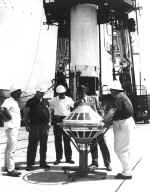1958
1958 The SS-10, an antitank guided missile produced by Nord Aviation of France, was adopted for use by the U.S. Armed Forces. It was basically designed for ground forces.
January 58 Personnel of the Redstone Arsenal Judge Advocate's Office discovered that the State of Alabama had never ceded jurisdiction to over 7,000 acres of land comprising a part of the Army reservation. Successful action was taken to acquire this jurisdiction.
January 58 Raytheon delivered the first prototype HAWK missile. Previously, the U.S. Marine Corps (USMC) had become a full participant in the HAWK program.
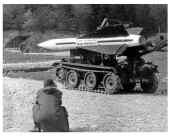
January 58 With the approval of the REDEYE feasibility study, the Chief of Ordnance assigned national mission responsibility for the project to Redstone Arsenal.
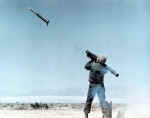
January to June 58 During this period, the DA program for recognizing length-of-service records for federal employees was added to the RSA awards program. It was expected that several thousand arsenal employees would be awarded certificates and lapel pins for 10, 20, 30, 40, and 50 years of service.

1 January 58 A U.S. Post Office was established at Redstone Arsenal, and the installation's address was changed from Redstone Arsenal, Huntsville, Alabama, to Redstone Arsenal, Alabama.
7 January 58 The Joint Chiefs of Staff recommended and the Secretary of Defense approved authorization for the Army to proceed with development of a solid-propellant missile to replace the REDSTONE. This approved replacement was initially known at ABMA as the REDSTONE-S (solid).
10 January 58 The Missile Planning Office was established as a field staff office of the Chief of Ordnance located at RSA. Although not a part of ABMA, the office was an adjunct to the command. The office's mission was to assure the development of long-range plans for military and scientific achievements in the missile and related fields, exercising the widest possible latitude in advanced thinking.
16 January 58 DOD announced that the new solid-propellant missile approved on 7 January was designated the PERSHING in honor of General of the Armies of the United States John J. Pershing, famed commander of the American Expeditionary Forces during World War I.
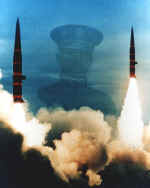
22 January 58 The National Security Council assigned the highest national priority to the NIKE ZEUS Antimissile Missile development program.
30 January 58 CONARC approved the first design concept of the LAW weapon system.
|
|
31 January 58 JUPITER C Missile RS-29 successfully placed EXPLORER I, the first U.S. satellite, into orbit around the earth. The Navy did not successfully launch a VANGUARD satellite until 17 March 58. The EXPLORER I reentered the earth's atmosphere on 31 March 70.
February 58 Actual R&D effort on the LAW began at the Redstone Arsenal complex.
19 February 58 The Secretary of the Army assigned responsibility for overall direction of the PERSHING I missile development program to the Army Ballistic Missiles Committee. At the same time, he gave ABMA control over PERSHING I systems management and engineering development.
5 March 58 JUPITER C Missile RS-26 did not place EXPLORER II into orbit because the last stage failed to ignite.
20 March 58 The Secretary of the Army announced that the U.S. Army Ordnance Missile Command (AOMC), to be headed by MG John B. Medaris, would be established at Redstone Arsenal effective 31 March 58. The actual formation of the command began on 26 March, when a full-time working group was established to plan and develop the organization and method of operation throughout the command complex.
26 March 58 JUPITER C Missile RS-24 successfully launched the 31-pound EXPLORER III satellite into orbit. Even though it had the same type carrier vehicle as the EXPLORER I, the EXPLORER III's instrumentation included a miniature tape recorder not carried on the first satellite. This recorder made it possible to collect data on radiation, micrometeorite impact, and temperatures throughout the entire orbit, then relay this information back to earth. The satellite reentered the earth's atmosphere on 28 June 58.
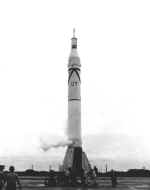
27 March 58 The Secretary of Defense assigned ABMA the mission of launching two lunar probes.
28 March 58 The Martin Company of Orlando, Florida, was awarded a letter contract for R&D and initial production of the PERSHING I system under the technical supervision and concept control of the Army. The letter contract was definitized on 25 June 58.
31 March 58 Because of the increasing importance of missilery and the pressing need for exploiting resources to their maximum capabilities, DA created AOMC. Headquartered on Redstone Arsenal, the command was under the jurisdiction of the Chief of Ordnance. Its subordinate elements included ABMA; Redstone Arsenal; the Jet Propulsion Laboratory at the California Institute of Technology in Pasadena, California; and White Sands Proving Ground in New Mexico. The latter was renamed White Sands Missile Range (WSMR) effective 1 May 58.
Among the major weapon systems for which AOMC had overall management responsibility were the REDSTONE, JUPITER, PERSHING, NIKE HERCULES, NIKE ZEUS, HAWK, PLATO, SERGEANT, HONEST JOHN, LITTLEJOHN, LACROSSE, DART, and CORPORAL. The command also carried out the Army's outer space projects for the Advanced Research Projects Agency (ARPA).
MG John B. Medaris, formerly ABMA Commander, became the first Commanding General of AOMC, while MG Holger N. Toftoy, previously the RSA Commander, became AOMC's Deputy Commander. BG John A. Barclay succeeded General Medaris as Commander of ABMA.
31 March 58 The first JUPITER classes for Air Force personnel began at OGMS, using REDSTONE training equipment.
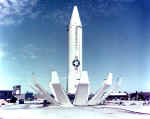
April 58 Convair received a contract for a REDEYE feasibility study. The REDEYE was a manportable system which used an infrared homing system to engage low flying tactical aircraft. The Ordnance Technical Committee officially approved this project on 12 June 58.
April 58 Production of the NIKE AJAX system ended with the delivery of the last missile during this month.
1 April 58 The Army Rocket and Guided Missile Agency was organized as a subordinate element of AOMC. Although not officially established as an activity under the jurisdiction of the Chief of Ordnance until 1 June 58, ARGMA assumed the technical missions formerly assigned to Redstone Arsenal. BG John G. Shinkle served as the first ARGMA commander.
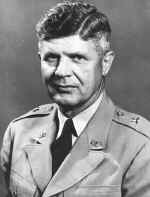
1 April 58 After relinquishing its technical missions to ARGMA, RSA's primary mission was to provide administrative and logistical support services to AOMC Headquarters, ABMA, ARGMA, and OGMS. Its responsibilities included the provision of security, fire, and safety services; operation of medical facilities; maintenance of roads and buildings; provision of administrative services such as finance and printing; and support of military units assigned to the arsenal.
2 April 58 President Eisenhower recommended to Congress that a civilian agency be established to direct nonmilitary space activities.
24 April 58 Redstone Arsenal acquired 40.5 acres of Tennessee Valley Authority (TVA) land located on Lake Guntersville for the recreational use of its military personnel. The lease signed on this date stipulated a period of 19 years. Another 1.5 acres of privately owned land was acquired to permit easier access to the recreational area. A 19-year lease for a consideration of $35 annually was executed on 30 June 58. Both leases contained options on a second 19-year lease if the Army so desired.
30 April 58 The JUPITER Project Office moved out of the ABMA Control Office to become a separate organization reporting directly to the commanding general.
May 58 In keeping with guidance from higher authorities, the Chief of Ordnance advised CONARC that no further work would be done on the Phase I LITTLEJOHN except that which was directly applicable to the development of the Phase II optimum system. The Ordnance Corps retained the interim LITTLEJOHN in active war reserve status for the next 28 months.
1 May 58 The AOMC Commander established a West Coast Field Office as a tenant on the premises of the Los Angeles Ordnance District.
5 May 58 The HAWK missile successfully intercepted and destroyed a QF-80 Jet Fighter Target Drone flying at treetop level. This was the first intercept of very low altitude aircraft.
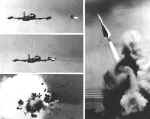
5 May 58 Redstone Arsenal was officially reorganized. It also assumed some additional duties, including responsibility for the Transportation Branch Motor Pool; the Intelligence & Security Office; the Traffic Management Office; and the Training Branch, Civilian Personnel Office.
13 May 58 The ABMA Commander, BG John A. Barclay, received his pilot wings.
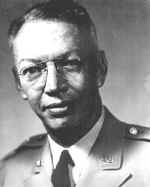
16 May 58 The first successful troop launching of a tactical REDSTONE missile occurred at Cape Canaveral, Florida.

18 May 58 JUPITER Missile AM-5, carrying the United States' first tactical type reentry nose cone, was fired from Cape Canaveral. This was also the first flight test for first and second stage separation. In less than 5 hours the nose cone was retrieved, marking the world's first recovery of an IRBM nose cone.
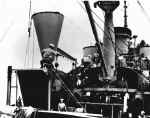
22 May 58 MAJ Henry R. Del March, AOMC Transportation Office Chief, presented to the Secretary of the Army and the Army Chief of Staff letters recovered from the first tactical reentry nose cone.
June 58 The REDSTONE was the first large U.S. ballistic missile to be deployed overseas. It joined the NATO Shield Force.
June 58 The NIKE HERCULES was first deployed and accelerated production of the system began during this month.
2 June 58 The first overland firing of a large U.S. ballistic missile by combat troops occurred. The 40th Field Artillery Missile Group (Heavy) successfully launched a REDSTONE at WSMR.
17 June 58 The first troop train in RSA's history was furnished by Southern Railway Company to move the main body of the 40th Field Artillery Missile (Heavy) Group to the port of embarkation for deployment overseas. A total of 18 pullman cars made up the train, and 18 government busses were used to transport the group from their headquarters to the train.
17 June 58 The first flight test of the XM-50 Improved HONEST JOHN Rocket was successfully conducted.
18 June 58 The first REDSTONE tactical missile unit, the 40th Field Artillery Group (Heavy), successfully deployed overseas.
23 June 58 The AOMC Commander ordered that an Army Field Office be established at the Atlantic Missile Range (AMR), Patrick AFB, Florida.
27 June 58 The first overseas airlift of a REDSTONE missile was accomplished.
27 June 58 AOMC established a Liaison Office with the U.S. Navy at Sunnyvale, California, for work on the POLARIS project.
28 June 58 The switchover from NIKE AJAX to NIKE HERCULES began when the first battalions of the latter system were deployed in the Continental United States (CONUS) at Washington, D.C.; New York City, New York; and Chicago, Illinois. The last AJAX was delivered in April 58.
July 58 The first testing of antiaircraft missiles began against target drones flying in formation. During this testing, a NIKE HERCULES missile picked off the lead F-80 drone and destroyed it.
July to December 58 The Protocol Office was established within AOMC Headquarters as an organizational segment of the Chief of Staff. In addition to acting as the visitor control office for the command, it maintained technical supervision over visitor control functions throughout AOMC.
July to December 58 A major change was instituted in the Wage Board (WB) program during this period. The number of WB grade levels was reduced from 28 to 15, with steps within a grade ranging from 4 to 3 for nonsupervisors.
July to December 58 The new obstetrical service opened in the Post Hospital.
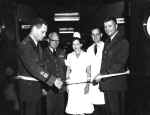
July to December 58 Work started on the arsenal's first golf course.
1 July 58 The establishment of Chrysler Corporation Missile Plant 22 at Huntsville was announced. Space in the Huntsville Industrial Center was occupied beginning 25 September 58.
1 July 58 The capabilities of the entire family of Ordnance weapons were publicly demonstrated in the Army Missile Mobility Orientation (Project AMMO) held at WSMR. Designed to show off the Army's firepower, nine missiles were launched, eight of which had been developed under the supervision of the RSA complex.
1 July 58 The first HAWK intercept photographs to be released to the public were taken during Project AMMO. The HAWK scored a direct hit on an F-80 Shooting Star jet fighter.
8 July 58 Authority to convene general courts-martial was granted to the AOMC and RSA Commanders at the installation's request.
15 July 58 AOMC was assigned the OCO alternate headquarters mission, which provided for the continuity of OCO operations in the event of an enemy attack under Condition ALFA (attack without warning).
17 July 58 JUPITER Missile AM-6B was fired from Cape Canaveral, Florida. This was the first flight test of the complete inertial guidance system. The missile impacted on the predicted target, and its nose cone was successfully recovered less than 2 hours after liftoff.
25 July 58 Test firings conducted on this date demonstrated the capability of the NIKE HERCULES to single out a specific target among a group of aircraft flying at different altitudes in different directions.
26 July 58 JUPITER C Missile 44 successfully placed EXPLORER IV into orbit. The satellite's primary purpose was to measure high energy radiation. The satellite reentered the earth's atmosphere on 23 October 59.
28 July 58 Units of the Troop Command participated in a farewell parade for MG Holger N. Toftoy, AOMC Deputy Commander. General Toftoy left RSA to assume duties as Commander of Aberdeen Proving Ground, Maryland. He remained in that post until his retirement on 24 February 60.
29 July 58 President Eisenhower signed the National Aeronautics and Space Act of 1958, creating the National Aeronautics and Space Administration (NASA).
31 July 58 A REDSTONE missile was fired to an altitude in excess of 200,000 feet, where a megaton nuclear device was detonated. This was the first such test accomplished by the United States.
19 August 58 The Pacific Missile Range Army Field Office, located at Point Magu, California, was established as an AOMC Field Office and organizationally assigned to the AOMC Control Office.
24 August 58 JUPITER C Missile 47 was launched in an attempt to carry the EXPLORER V satellite into orbit. However, this attempt failed because the booster collided with the top section shortly after separation, causing the altitude reference to fire in the wrong direction.
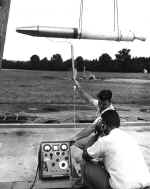
26 August 58 Redstone Arsenal's $32 million construction program was shut down by a strike. Union workers refused to pass picket lines set up at all of the installation's main gates by Local 558 of the International Brotherhood of Electrical Workers. Picketing was preceded by a walkout of construction electricians at 1200, 22 August.
Although the stated cause of the strike was to protest the wages and working conditions of the Baroco Electric Construction Company of Pensacola, Florida, which had contracted to expand RSA's electrical power facilities, other reports indicated that the picketing was directed at the firm's open-shop policy. Despite efforts by the Corps of Engineers, the Redstone Provost Marshal, the National Labor Relations Board, and a Federal District Court order, the strike continued until 26 September. This was the longest work stoppage in the arsenal's history.
27 August 58 JUPITER Missile AM-7 was fired from Cape Canaveral. This was the first flight test of the warhead and fuze system as well as the solid propellant spin rocket and vernier motor.
28 August 58 The Army delivered JUPITER Missile 101, the first initial operational capability weapon, to the Air Force.
September 58 ARGMA received DA guidance to continue development of the XM-50 Improved HONEST JOHN to completion.
12 September 58 The OCO advised AOMC that DOD and DA decided that the DART program should be terminated. The next day, the OCO directed the program be terminated effective 15 September 58. The French SS-10 and SS-11 antitank missiles were evaluated as possible replace-ments for the DART.
23 September 58 After AOMC and ARPA signed a memorandum of understanding on this date, the SATURN program began at ABMA under Army management. SATURN design studies were authorized to proceed at RSA for development of a 1.5-million pound thrust, clustered engine first stage.
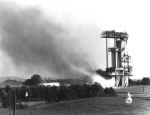
1 October 58 The formal opening of the RSA eight-lane bowling alley was held.
1 October 58 Pursuant to recommendations by the Inspector General and the Army Audit Agency, ARGMA assumed responsibility from Redstone Arsenal for all functions pertaining to government-owned, contractor-operated (GOCO) contract operations.
1 October 58 This was NASA's first official day. By executive order of President Eisenhower, DOD responsibilities for the remaining U.S.-IGY satellite and space probe projects were transferred to the new civilian agency on 21 October.
6 October 58 Believing that the RSA complex should have a biomedical capability as a part of the bioastronautic research program, the Surgeon General of the Army assigned liaison personnel to AOMC Headquarters.
17 October 58 The 23d Ordnance Company (REDSTONE) was activated at RSA.
17 October 58 The OCO directed that the recruitment of civilian personnel be discontinued until 1 December, except for urgent positions that had to be filled to prevent the disruption of high priority missions. However, the hiring freeze remained in effect at year's end and was expected to continue "indefinitely."

|
22 October 58 JUPITER Missile C-49 was launched but failed to orbit EXPLORER VI because the payload broke off due to rotational spin vibration of the cluster.
24 October 58 The REDSTONE underwent static firing at WSMR, the first time such a test had been conducted at the facility.
28 October 58 Command responsibility for military police (MP) functions in Madison County, Alabama, was delegated to the AOMC Commander and further redelegated to the RSA Commander.
5 November 58 The REDSTONE R&D program was completed with the firing of REDSTONE Missile 57. Of the 37 R&D firings, 14 were considered successful, 21 were partially successful, and 2 were failures.
5 November 58 The Office, Chief of R&D, approved the classification of the SERGEANT as limited production. The Secretary of the Army approved the implementing action on 2 April 59.
14 November 58 The Chief of Ordnance authorized the AOMC Commander to issue letter contracts for the HAWK, CORPORAL, LACROSSE, and SERGEANT guided missile systems.
15 November 58 A JUPITER missile was accidently dropped in one of the RSA training areas.
17 November 58 AOMC Headquarters ended its joint occupancy of the ABMA Headquarters building (4488) when it opened for business in its new building (4505) on this date. The move was accomplished over a weekend to minimize the loss of management manhours.

24 November 58 The Army's first missile transportation seminar was held at RSA starting on this date. Lasting until 26 November, the purpose of the seminar was to acquaint military, regulatory, and commercial traffic representatives of industry with the Army's missiles.
26 November 58 The U.S. manned satellite space program using the REDSTONE as a booster was officially named Project MERCURY.

Project MERCURY astronauts with Von Braun
3 December 58 President Eisenhower approved the transfer of JPL from AOMC to NASA. The Army and the civilian agency reached an agreement whereby AOMC and its subordinate organizations would be responsive to NASA requirements. Under existing contracts with JPL, the Army was allowed to continue certain specific military projects through 1959. These programs included the SERGEANT missile effort, special intelligence investigations, secure communications research, and aerodynamic testing and research.
6 December 58 The Army's first lunar attempt--PIONEER III--was launched on this date and went 66,654 miles toward the moon. Although it failed as a lunar probe, PIONEER III was considered to be a scientific success because it provided excellent data on radiation intensities as far out as 65,000 miles. It also proved that there were two distinct belts of very intense radiation. In addition, the launch was a successful test of the first four-stage JUNO II vehicle (modified JUPITER Missile II).
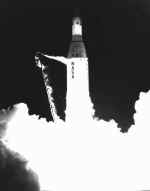
11 December 58 The RSA Troop Command organized a military ceremony to honor the visit of Crown Prince Constantine of Greece. Four ruffles and flourishes were given by the 296th Army Band from Fort McClellan, Alabama, while a firing battery of the 12th Artillery Battalion, Fort Benning, Georgia, rendered a 21-gun salute. The Honor Guard was furnished by the 291st MP Company, Redstone Arsenal, and the Color Guard was composed of represen-tatives of other units of the Troop Command.
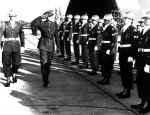
13 December 58 JUPITER Missile AM-13 was fired, marking the first successful flight of a JUPITER IRBM incorporating the tactical ballistic shell configuration. Also significant was the fact that the missile carried a squirrel monkey named Gordo over IRBM distance, contributing highly useful data for Army and Navy medical research into space flights. Even though Gordo made the flight with no known adverse affects, the monkey could not be recovered because the nose cone's flotation device failed.
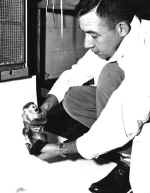
15 December 58 A NIKE HERCULES battalion was deployed on Formosa to assist in the defense of this Chinese Nationalist stronghold.
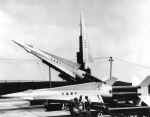
The ABMA/AOMC Era:
Introduction,
1956,
1957,
1958,
1959,
1960,
1961,
1962
